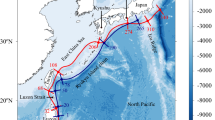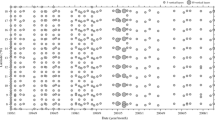Abstract
A time series of surface geostrophic velocity is developed using satellite altimetry data during 1992–2010 for a track across the Kuroshio southeast of Kyushu, Japan. The temporal mean geostrophic velocity is estimated by combining the along-track sea level anomaly and shipboard ADCP data. This approximately 6-km resolution dataset is successful in representing the Kuroshio cross-current structure and temporal variation of the Kuroshio current-axis position during 2000–2010. The authors use this dataset to examine the winter Kuroshio path destabilization phenomenon. Its seasonal features are characterized as follows: the velocity shear on the inshore side of the Kuroshio becomes stronger and the Kuroshio path state becomes unstable from the summer to winter. This evidence is consistent with the hypothetical mechanism governing the destabilization phenomenon discussed in a previous study. Furthermore, the interannual amplitude modulation of the seasonality is examined in relation to interannual variations in the winter northerly wind over the northern Okinawa Trough and the Pacific Decadal Oscillation (PDO) index. The destabilization phenomenon appears 15 times in the period 2000–2010. Ten cases are related to local wind effects, and 7 of these are also connected with the PDO index. This is probably because the winter northerly wind over the northern Okinawa Trough is regulated by the PDO signal in interannual time-scales. Only 4 cases are related to the PDO index, but their driving mechanism remains uncertain.











Similar content being viewed by others
References
Ambe D, Imawaki S, Uchida H, Ichikawa K (2004) Estimating the Kuroshio axis south of Japan using combination of satellite altimetry and drifting buoy. J Oceanogr 60:375–382
Andres M, Park JH, Wimbush M, Zhu XH, Nakamura H, Kim K, Chang KI (2009) Manifestation of the Pacific Decadal Oscillation in the Kuroshio. Geophys Res Lett 36:L16602. doi:10.1029/2009GL039216
Eady ET (1949) Long waves and cyclone waves. Tellus 1(3):33–52
Emery WJ, Thomson RE (2001) Data analysis methods in physical oceanography. Elsevier, Amsterdam
Farge M (1992) Wavelet transforms and their applications to turbulence. Annu Rev Fluid Mech 24:395–457
Ichikawa K (2001) Variation of the Kuroshio in the Tokara Strait induced by meso-scale eddies. J Oceanogr 57:55–68
Kawabe M (1995) Variations of current path, velocity, and volume transport of the Kuroshio in relation with the large meander. J Phys Oceanogr 25:3103–3117
Kuragano T, Shibata A (1997) Sea surface dynamic height of the Pacific Ocean derived from TOPEX/POSEIDON altimeter data: Calculation method and accuracy. J Oceanogr 53:585–599
Mantua NJ, Hare SR, Zhang Y, Wallace JM, Francis RC (1997) A Pacific interdecadal climate oscillation with impacts on salmon production. Bull Am Meteorol Soc 78:1069–1079
Maximenko N, Niiler P, Rio MH, Melnichenko O, Centurioni L, Chambers D, Zlotnicki V, Galperin B (2009) Mean dynamic topography of the ocean derived from satellite and drifting buoy data using three different techniques. J Atmos Ocean Technol 26:1910–1919. doi:10.1175/2009JTECHO672.1
Nakamura H (2005) Numerical study on the Kuroshio path states in the northern Okinawa Trough of the East China Sea. J Geophys Res 110:C04003. doi:10.1029/2004JC002656
Nakamura H, Ichikawa H, Nishina A, Lie HJ (2003) Kuroshio path meander between the continental slope and the Tokara Strait in the East China Sea. J Geophys Res 108(C11):3360. doi:10.1029/2002JC001450
Nakamura H, Yamashiro T, Nishina A, Ichikawa H (2006) Time-frequency variability of Kuroshio meanders in Tokara Strait. Geophys Res Let 33:L21605. doi:10.1029/2006GL027516
Nakamura H, Nishina A, Ichikawa H, Nonaka M, Sasaki S (2008) Deep countercurrent beneath the Kuroshio in the Okinawa Trough. J Geophys Res 113:C06030. doi:10.1029/2007JC004574
Nakamura H, Nonaka M, Sasaki H (2010) Seasonality of the Kuroshio path destabilization phenomenon in the Okinawa Trough: a numerical study of its mechanism. J Phys Oceanogr 40:530–550. doi:10.1175/2009JPO4156.1
Niiler PP (1969) On the Ekman divergence in an oceanic jet. J Geophys Res 74:7048–7052
Rio MH, Hernandez F (2004) A mean dynamic topography computed over the world ocean from altimetry, in situ measurements, and a geoid model. J Geophys Res 109:C12032. doi:10.1029/2003JC002226
Rossby T, Zhang HM (2001) The near-surface velocity and potential corticity structure of the Gulf Stream. J Mar Res 59:949–975
Torrence C, Compo GP (1998) A practical guide to wavelet analysis. Bull Am Meteorol Soc 79:61–78
Uchida H, Imawaki S (2003) Eulerian mean surface velocity field derived by combining drifter and satellite altimeter data. Geophys Res Lett 30:1229. doi:10.1029/2002GL016445
Yamashiro T, Kawabe M (1996) Monitoring of position of the Kuroshio axis in the Tokara Strait using sea level data. J Oceanogr 52:675–687
Yamashiro T, Kawabe M (2002) Variation of the Kuroshio axis south of Kyushu in relation to the large meander of the Kuroshio. J Oceanogr 58:487–503
Acknowledgments
Thanks go to the crew of the T/V Kagoshima-maru, Kagoshima University for their assistance at sea, and two anonymous reviewers for their important comments. Wavelet software was provided by C. Torrence and G. Compo, and is available at URL: http://paos.colorado.edu/research/wavelets. This work was supported by the Japan Society for the Promotion of Science [Grant-in-Aid for Scientific Research (c), No. 20540428].
Author information
Authors and Affiliations
Corresponding author
Appendix: A hypothetical mechanism of the Kuroshio path destabilization
Appendix: A hypothetical mechanism of the Kuroshio path destabilization
1.1 A general overview
Nakamura et al. (2010) investigated the Kuroshio path destabilization phenomenon in the northern Okinawa Trough for the winter–spring period, using data from a realistic high-resolution simulation with the OGCM for the Earth Simulator (referred to as OFES). Figure 12, based on the OFES data, is a schematic showing evolutions of the wind stress field, effective Ekman upwelling intensity and Kuroshio meander activity from the summer to winter. The wind stress over the East China Sea changes drastically from August to October. The October wind stress, which has a tendency of the winter wind stress, is directed antiparallel to the Kuroshio over the northern Okinawa Trough. This wind stress results in the effective Ekman upwelling along the inshore side of the Kuroshio in the northern Okinawa Trough and hence the uplift of the upper thermocline there. The dynamics of this process are explained in detail in the next subsection, based on a simple wind-driven Ekman-pumping model, acting within the Kuroshio. The October upwelling acts to make the mean Kuroshio path separate from the continental slope in the northern Okinawa Trough, so that baroclinic instability destabilizes the Kuroshio path as shown by Nakamura’s (2005) numerical simulations: the Kuroshio path state transitions from a stable path state to an unstable path state when the maximum surface velocity location of the inflow is shifted seaward with the detachment of the shoreward boundary of the current from the continental slope. As soon as the effective Ekman upwelling causes instability, large upwelling can occur on the inshore side of the current because of the cyclonic eddies developing from the frontal meanders in the northern Okinawa Trough. The upwelling and path destabilization in December are, therefore, intensified more and more compared to those in October.
A schematic drawing of temporal evolutions of wind stress field (vectors), intensity and area of upwelling (colors: red indicates stronger than yellow), and stability of the Kuroshio path (gray curves), based on Nakamura et al. (2010): a August, b October, and c December. Contours show 500 and 1,000 m isobaths (color figure online)
1.2 A wind-driven Ekman-pumping model
In order to examine the surface Ekman transport for the October situation in Fig. 12, we consider the f-plane ocean configured for the northern Okinawa Trough: the coordinates x and y are arranged to be the distances in the southeastward cross-slope and northeastward along-slope directions, respectively. The modeled ocean is therefore independent of y and dominated by northeastward geostrophic flow. For the steady problem, the equation for the depth-averaged Ekman flow, \( \overline{{u_{\text{a}} }} (x ) \), within the geostrophic velocity, \( v_{\text{g}} (x ) \), is
where \( \tau_{y} (x ) \) is the wind stress for the y-component, \( \rho_{ 0} \) is the mean density, and d is the thickness of the surface Ekman layer (refer to Nakamura et al. 2010 for the derivation). This equation indicates that the distribution of depth-averaged Ekman flow is distorted by the effective Coriolis parameter (Niiler 1969), the sum of the earth’s rotation and the geostrophic velocity’s shear, within the strong jet stream. Such a distribution can be determined by (A1) with prescribed distributions of \( v_{\text{g}} (x ) \) and \( \tau_{y} (x ) \). According to the conservation of mass within the surface Ekman layer, the distribution of the Ekman pumping velocity, \( w_{\text{E}} (x ) \), is given by
Two demonstrations are shown in Fig. 13. One is the response of the western boundary current (WBC) with a double-exponential velocity structure on uniform southwestward wind stress (Fig. 13a). It is known that the Gulf Stream takes the double-exponential velocity structure for the near-surface velocity section, when averaged in stream coordinates (Rossby and Zhang 2001), because of uniform potential vorticity to either side of the current axis. The double-exponential WBC on uniform southwestward wind stress generates upwelling and hence uplift of the upper thermocline within the current, resulting in the detachment of the shoreward boundary of the current from the continental slope. This upwelling system is, however, not self-consistent, because \( \bar{u}_{\text{a}} \) is discontinuous at the current axis so that strong downwelling occurs there. A vertical circulation in the cross-stream direction, so called the Ekman cell, is formed by \( \bar{u}_{\text{a}} \) and \( w_{\text{E}} \) on the inshore side of the current, while the Ekman cell cannot be formed on the offshore side of the current because the strong downwelling at the current axis suppresses development of the Ekman cell on the offshore side. The initial exponential velocity structure is therefore modified to vanish upwelling on the offshore side of the current. A plausible modification in velocity profile may be constructed to the real winter wind stress. Figure 13b shows such a case, i.e., the response of the WBC with an exponential-parabola velocity structure on the southwestward wind stress whose amplitude decreases linearly to the southeast. This solution has the merit that the jump discontinuity of \( \bar{u}_{\text{a}} \) at the current axis is suppressed but suffers the demerit that the current speed is weakened. The OFES data supports this solution because the surface Ekman transport tends to be uniform on the offshore side of the Kuroshio, resulting in the tendency for the upwelling to occur only on the inshore side of the Kuroshio.
Cross-sections showing the response of the WBC along the continental slope to the local wind stress blowing against the current, based on Nakamura et al. (2010): a the WBC with a double-exponential velocity structure on uniform southwestward wind stress, and b the WBC with an exponential-parabola velocity structure on the southwestward wind stress whose amplitude decreases linearly to the southeast. Arrows and black (red) solid curves on the sea surface indicate wind stresses and the initial (wind-forced) velocity profile, respectively. Arrows with green lines and black (red) solid curves in the cross-section express the flow pattern and the initial (wind-forced) upper thermocline, respectively. Shading around the current axis indicates the region where the current structure is not self-consistent (color figure online)
Rights and permissions
About this article
Cite this article
Nakamura, H., Nishina, A., Tabata, K. et al. Surface velocity time series derived from satellite altimetry data in a section across the Kuroshio southwest of Kyushu. J Oceanogr 68, 321–336 (2012). https://doi.org/10.1007/s10872-012-0101-4
Received:
Revised:
Accepted:
Published:
Issue Date:
DOI: https://doi.org/10.1007/s10872-012-0101-4






